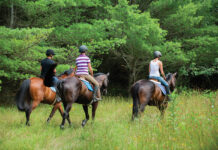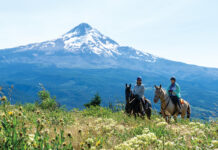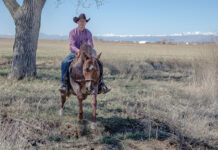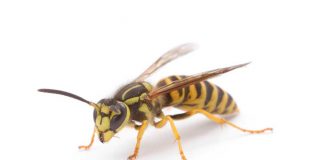Every horse will spook at something sometime. There are a variety of methods for dealing with this problem, so experiment to find the approach that works best for you.
“If it’s something you’re going to have to pass every time you go out, I’d rather spend time getting the horse really used to the thing,” Reynolds adds. However, if it’s something you’ll likely never encounter again, Reynolds advises moving past it.
Hall tries to keep his horses moving forward down the trail rather than focusing on the object of fear. “I want my horses to be forward-thinking without much hesitation,” he says. To get his horses moving forward, Hall maintains contact with his legs and reins, and encourages them to continue down the trail at whatever pace they were going.
Take a closer look. “If it’s their first time seeing something, I usually let them go and check it out,” Reynolds says.
However, not all horses will walk up to something they’re afraid of. “If there’s a way to get off and lead the horse to it, that’s another option,” Reynolds suggests.
Try approach and retreat. “If I’m riding a horse that is not very confident and tends to spook, I’ll do whatever I can to help him handle the situation at hand,” Falcone says. “I’ll back him away from the spooky thing, and then walk him toward it—approach and retreat—until he is able to see that there is nothing to be afraid of. I do not punish the horse in any way. I want to build confidence in my horses and help them think their way through scary situations. It’s important to remain calm and focused and prove to your horse that he can rely on you to keep him safe.”
Get control of your horse during the spook. Horses that spook may shy sideways or run forward. When this happens, the rider needs to quickly gain control. Reynolds suggests bending the horse to a stop. “Take one rein and pull it in toward your stomach,” she explains. “Take your leg off of the horse because otherwise you’re asking the horse to spin. You want to bend the horse’s nose toward your leg.” The goal is to get your horse to stop. Even if he isn’t familiar with this method of stopping, the bending will slow him down and help him focus his attention back on you and what you’re asking.
Do your homework. “If you can desensitize your horses [at home], in the long run that will pay off,” Reynolds says. “If you take them into the arena and show them items and try things like bridges, you can get them used to those objects.
“Think of as many things as you can to expose your horse to—whatever weird things he may see on the trail,” Reynolds continues.
It’s best if the horse is at liberty in a safe area when you do this. Be careful not to crowd him, otherwise you’re at risk of getting hurt.
After you’ve introduced items to your horse at liberty, you can try leading him up to things, such as a human wearing a backpack or carrying an umbrella.
Let your horse live outdoors. “A lot of times pasture horses are much less spooky than stall-kept horses because they’re outside; they see deer; they see birds; they see stuff blowing by in the wind more so than a stalled horse,” Reynolds says.






Excellent article. Very helpful.
So many great tips in this article that are so important to remember.
This is more of a question then comment, hope you can help me. I am taking lessons to learn how to ride ( for pleasure riding ). Everything was going fine when all of a sudden the horse I was on bolted, that’s what I was told he did. When that happened I ended up on the ground, yes I had a helmet on. Since I am learning and don’t have the riding experience what can I do? Yes my instructor made me get back on and I am glad I did. Help. Vicki
I have a mare that spooks at nothing and even things she has seen many times. She has good days and bad days. She doesn’t take off or bolt but shakes and/or grounds herself. She’s ten going on two, never bred, kept in a 1/4 to 1/3 of an acre with two other horse she has been since birth. She gets separation anxiety, especially when separated from the other mare. The gelding gets it when we take his girls without him but not a spooky horse.
I have a pretty solid 21 year old paint who has seen almost everything, but will occasionally still spook. One of the worst ones was on the way home from a long trail ride. The round bale that was fine on the way out, was terrifying on the way back. He jumped sideways about 6 feet. I have heard this is because of a horse’s so called split brain. What he sees with one eye and that side of the brain is news to the other eye and that side of the brain. Can anyone confirm?
This is exactly the problem my horse seems to have.
Good advice. Another thing that I do is have a word, “calm” that I use to assure the horse that it’s not a problem. When he hears me say that he’s like, “Oh okay! It’s fine if you say so.”
After reading through all these trail problems, the main idea is to stay calm, which will help you and your horse,
It’s so true, my horses are outside 24/7 and they don’t spook at much. When they do, it’s just a little hop to the side.